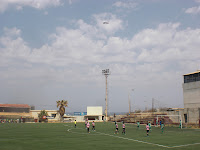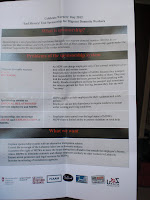Deep in the mountains of formerly occupied southern Lebanon
lies Mleeta, once a stronghold for Hezbollah guerrillas, today a tour de force
in museum architecture and propaganda.
 Sunshine bathed the rocky southern Lebanese hills
as an
aging blue-green Mercedes taxi took us through several small Shia towns
on the way
into the countryside. Many of these small towns display posters and
banners
along the roadside or in their town squares, showing pictures of
Hezbollah
leader Hassan Nasrallah and other political figures and martyrs past and
present from both
Hezbollah and its political ally Amal. The unmistakeable yellow and
green flag of Hezbollah flies everywhere here. Once the car had passed
through the town of Mleeta
itself, and continued up the mountainside for a few more kilometres, the
$25 million spectacular that is the ‘Mleeta Resistance Tourist
Landmark’ appeared, sitting on the crest of a hill overlooking the
valley.
Sunshine bathed the rocky southern Lebanese hills
as an
aging blue-green Mercedes taxi took us through several small Shia towns
on the way
into the countryside. Many of these small towns display posters and
banners
along the roadside or in their town squares, showing pictures of
Hezbollah
leader Hassan Nasrallah and other political figures and martyrs past and
present from both
Hezbollah and its political ally Amal. The unmistakeable yellow and
green flag of Hezbollah flies everywhere here. Once the car had passed
through the town of Mleeta
itself, and continued up the mountainside for a few more kilometres, the
$25 million spectacular that is the ‘Mleeta Resistance Tourist
Landmark’ appeared, sitting on the crest of a hill overlooking the
valley.Hezbollah is officially classified as a terrorist organisation in many Western countries, including, significantly and not surprisingly, the United States and Britain. The truth is far less black and white, although entirely subjective. But to cut a long story extremely short, they are a Shia Muslim political party and militant group formed in 1982 in response to the Israeli occupation of southern Lebanon, which at the time extended all the way to and included Beirut, to tragic consequences. They carried out military operations and guerrilla warfare against the Israeli occupying forces until these withdrew in 2000. They now have a huge influence in Lebanese politics, holding positions in the government and with a very strong military presence in the south. Controversial for their extremely staunch anti-Israel stance, military tactics and alleged financial backing from Iran and Syria, they nevertheless enjoy no shortage of support among many communities within Lebanon due to their ability to defend the country from what many see as unjust and overly aggressive Israeli attacks, something the Lebanese Army is not always able to do. This is an attempt at a neutral presentation of a very complicated situation and any mistakes or omissions are entirely my own.
 The museum at Mleeta is quite unlike any other.
Built on territory
from which Hezbollah fighters based their resistance efforts against
occupying Israeli forces in southern Lebanon until
2000, the hillside has since been bankrolled into a first-class museum. A
team
of top architects worked on the museum’s design. The result is in turns
impressive, surreal, bizarre and grotesque. A centrepiece named ‘The
Abyss’, a huge
collection of captured and destroyed Israeli tanks, artillery, jeeps and
even
soldiers’ helmets, is set up in a meticulously designed arrangement
encircled
by a walkway symbolising, in the words of the guide, the ‘tornado’ that
the
occupying forces found themselves caught in. The piece de resistance is a
Merkava 4 tank
-the pride of the Israeli army - half buried in the ground with its
turret tied in a knot. ‘We have no problems with any other groups or
religions, and have Christian visitors, Sunni visitors, everyone’
continued the
guide. ‘The only time we have a problem is if somebody wants to occupy
our
land’.
The museum at Mleeta is quite unlike any other.
Built on territory
from which Hezbollah fighters based their resistance efforts against
occupying Israeli forces in southern Lebanon until
2000, the hillside has since been bankrolled into a first-class museum. A
team
of top architects worked on the museum’s design. The result is in turns
impressive, surreal, bizarre and grotesque. A centrepiece named ‘The
Abyss’, a huge
collection of captured and destroyed Israeli tanks, artillery, jeeps and
even
soldiers’ helmets, is set up in a meticulously designed arrangement
encircled
by a walkway symbolising, in the words of the guide, the ‘tornado’ that
the
occupying forces found themselves caught in. The piece de resistance is a
Merkava 4 tank
-the pride of the Israeli army - half buried in the ground with its
turret tied in a knot. ‘We have no problems with any other groups or
religions, and have Christian visitors, Sunni visitors, everyone’
continued the
guide. ‘The only time we have a problem is if somebody wants to occupy
our
land’.  As well as The Abyss, we watched a 10-minute
film in an large theatre which documented the history of the
Hezbollah-Israel conflict. Including images of attacks by both sides,
accompanied by Nasrallah’s powerful speeches and a dramatic score, this
was a full-on propaganda broadside. We then took a walk amongst the
trees and plants of the hillside, where there were several exhibits on
guerrilla warfare;
models of soldiers which contributed to an eerie atmosphere as they
appeared
through the trees; and a 200-metre long underground tunnel including a
number
of bunkers. The tunnel opened out onto a spectacular view over the
countryside and
surrounding villages. At the end you arrive at a small bunker where
'Hizbu Allah' (Party of God) is sprayed onto the outside wall. An
anti-aircraft gun still stands on the inside.
As well as The Abyss, we watched a 10-minute
film in an large theatre which documented the history of the
Hezbollah-Israel conflict. Including images of attacks by both sides,
accompanied by Nasrallah’s powerful speeches and a dramatic score, this
was a full-on propaganda broadside. We then took a walk amongst the
trees and plants of the hillside, where there were several exhibits on
guerrilla warfare;
models of soldiers which contributed to an eerie atmosphere as they
appeared
through the trees; and a 200-metre long underground tunnel including a
number
of bunkers. The tunnel opened out onto a spectacular view over the
countryside and
surrounding villages. At the end you arrive at a small bunker where
'Hizbu Allah' (Party of God) is sprayed onto the outside wall. An
anti-aircraft gun still stands on the inside.On the way towards the exit, the Hezbollah experience can be completed by picking up a souvenir or two from the gift shop – a flag, a history book, or a child’s baseball cap printed with a picture of a smiling Nasrallah together with Iranian president Mahmoud Ahmadinejad. Classes of schoolchildren ran around us, enjoying their day out. They were Muslim children - I doubt schools in Christian areas would bring their classes here - but was their trip education or instruction? I think the line at Mleeta is a fine one.














